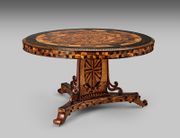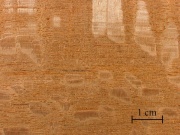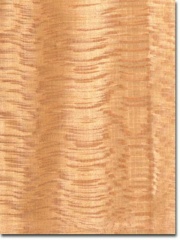Difference between revisions of "Lacewood"
| (4 intermediate revisions by the same user not shown) | |||
| Line 2: | Line 2: | ||
[[File:Lacewood.jpg|thumb|Lacewood (Silky oak) (''Grevillea robusta'')]] | [[File:Lacewood.jpg|thumb|Lacewood (Silky oak) (''Grevillea robusta'')]] | ||
== Description == | == Description == | ||
| − | A common name wood from numerous trees with striking patterns in their cut planks. Most species are found in Australian, southeast Asia | + | A common name wood from numerous trees with striking patterns in their cut planks. Most species are found in Australian, southeast Asia, |
or South America. Two significant types are: | or South America. Two significant types are: | ||
| Line 9: | Line 9: | ||
2) A reddish brown wood quartersawed from sycamore trees (''Platanus occidentalis'') native to the eastern United States. It is sold commercially as lacewood because the quartersawed wood has a grain pattern with characteristic flake-shaped markings. The surface is fine-grain and it polishes to a high gloss. The wood is used for tool handles, furniture, flooring, and veneer. | 2) A reddish brown wood quartersawed from sycamore trees (''Platanus occidentalis'') native to the eastern United States. It is sold commercially as lacewood because the quartersawed wood has a grain pattern with characteristic flake-shaped markings. The surface is fine-grain and it polishes to a high gloss. The wood is used for tool handles, furniture, flooring, and veneer. | ||
| − | 3) Other trees include: ''Gravillea robusta'' (eastern Australia); ''Lagetta lagetto'' (Caribbean), ''Roupala montana'' (South America). ''Roupala brailiensis'' (Brazil) | + | 3) Other trees include: ''Gravillea robusta'' (eastern Australia); ''Lagetta lagetto'' (Caribbean), ''Roupala montana'' (South America). ''Roupala brailiensis'' (Brazil); ''Panopsis spp.'' (Brazil) |
[[File:image5_lacewood.jpg|thumb|Lacewood (side cut)]] | [[File:image5_lacewood.jpg|thumb|Lacewood (side cut)]] | ||
== Synonyms and Related Terms == | == Synonyms and Related Terms == | ||
| − | lace wood; | + | lace wood; Brazilian Lacewood, South American Lacewood |
| − | 1 | + | 1) ''Cadwellia sublimis''; silky oak; northern silky oak; selano; bulk oak; oongaary; golden spanglewood |
| − | 2 | + | 2) ''Platanus occidentalis''; platano (It.); sycamore; Oriental plane |
== Physical and Chemical Properties == | == Physical and Chemical Properties == | ||
| − | 1. Tall tree, often reaching 30 m. Bark | + | 1. Tall tree, often reaching 30 m. Bark is thin. Leaves are entire and large, reaching 65cm length. Flowers occur in spring-summer producing profuse cream-white coverage, woody oval follicles and numerous winged seeds. Specific gravity = 0.60 (air dry); weight = 37 ppcf |
| − | 2. Large tree reaching to 40 m and 2 m diameter. Bark is mottled, flaking off in large masses. Leaves are alternate, palmately nerved, broadly ovate or orbicular, 10 to 23 cm (4 to 9 in) inches long. | + | 2. Large tree reaching to 40 m and 2 m diameter. Bark is mottled, flaking off in large masses. Leaves are alternate, palmately nerved, broadly ovate or orbicular, 10 to 23 cm (4 to 9 in) inches long. |
== Additional Images == | == Additional Images == | ||
| Line 36: | Line 36: | ||
* Ralph Mayer, ''A Dictionary of Art Terms and Techniques'', Harper and Row Publishers, New York, 1969 (also 1945 printing) | * Ralph Mayer, ''A Dictionary of Art Terms and Techniques'', Harper and Row Publishers, New York, 1969 (also 1945 printing) | ||
| − | |||
* Random House, ''Webster's Encyclopedic Unabridged Dictionary of the English Language'', Grammercy Book, New York, 1997 | * Random House, ''Webster's Encyclopedic Unabridged Dictionary of the English Language'', Grammercy Book, New York, 1997 | ||
| − | |||
* Wikipedia: https://en.wikipedia.org/wiki/Platanus_occidentalis (Accessed Oct. 2020); | * Wikipedia: https://en.wikipedia.org/wiki/Platanus_occidentalis (Accessed Oct. 2020); | ||
Latest revision as of 11:53, 18 November 2024
Description
A common name wood from numerous trees with striking patterns in their cut planks. Most species are found in Australian, southeast Asia, or South America. Two significant types are:
1) A pink wood with a distinctive ornamental figuring obtained from species Cadwellia sublimis native to Australia. Lacewood has a straight grain and coarse texture that is similar to Oak. Lacewood has a silver sheen and is used for veneer, inlays, cabinetry, flooring, boxes, and furniture.
2) A reddish brown wood quartersawed from sycamore trees (Platanus occidentalis) native to the eastern United States. It is sold commercially as lacewood because the quartersawed wood has a grain pattern with characteristic flake-shaped markings. The surface is fine-grain and it polishes to a high gloss. The wood is used for tool handles, furniture, flooring, and veneer.
3) Other trees include: Gravillea robusta (eastern Australia); Lagetta lagetto (Caribbean), Roupala montana (South America). Roupala brailiensis (Brazil); Panopsis spp. (Brazil)
Synonyms and Related Terms
lace wood; Brazilian Lacewood, South American Lacewood
1) Cadwellia sublimis; silky oak; northern silky oak; selano; bulk oak; oongaary; golden spanglewood
2) Platanus occidentalis; platano (It.); sycamore; Oriental plane
Physical and Chemical Properties
1. Tall tree, often reaching 30 m. Bark is thin. Leaves are entire and large, reaching 65cm length. Flowers occur in spring-summer producing profuse cream-white coverage, woody oval follicles and numerous winged seeds. Specific gravity = 0.60 (air dry); weight = 37 ppcf
2. Large tree reaching to 40 m and 2 m diameter. Bark is mottled, flaking off in large masses. Leaves are alternate, palmately nerved, broadly ovate or orbicular, 10 to 23 cm (4 to 9 in) inches long.
Additional Images
Resources and Citations
- Ralph Mayer, A Dictionary of Art Terms and Techniques, Harper and Row Publishers, New York, 1969 (also 1945 printing)
- Random House, Webster's Encyclopedic Unabridged Dictionary of the English Language, Grammercy Book, New York, 1997
- Wikipedia: https://en.wikipedia.org/wiki/Platanus_occidentalis (Accessed Oct. 2020);




